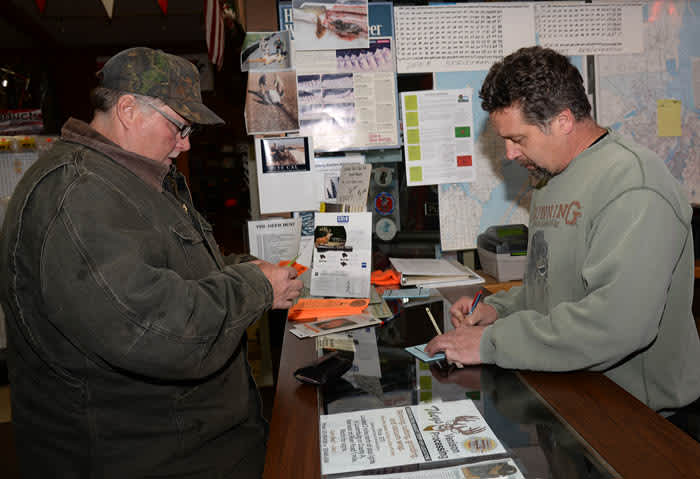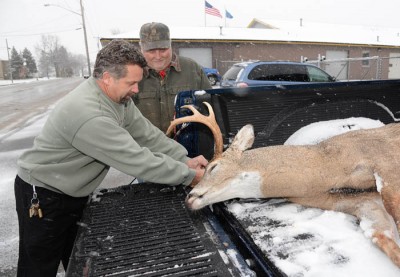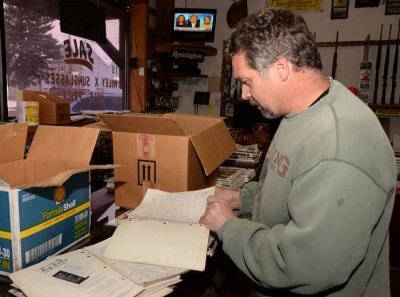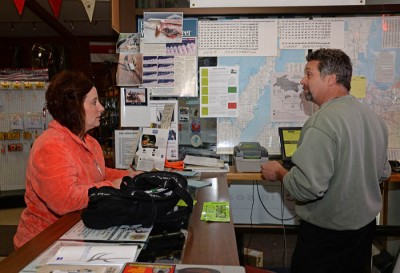Making Deer Registration a Community Affair
Patrick Durkin 12.09.14

If you want proof of deer hunting’s importance to Wisconsin—and why it’s foolish to schedule weddings or other events the first two days of deer season—drive east from Green Bay on opening day, turn south on Luxemburg’s Main Street, and look for Lee’s Sports.
Don’t worry. You can’t miss it. The gun shop is part of the Simonar family’s sprawling business complex on the road’s west side, sandwiched between Simonar Service and Simonar Sports. Chances are, you’ll hardly notice the buildings for all the headlights and red taillights. That section of road will be packed with SUVs and pickup trucks carrying freshly killed deer, all requiring registration at Lee’s Sports.
But not everyone in the crowd hunts. Cars, minivans and other soccer-mom vehicles park wherever there’s room to unload kids, friends and relatives for this dead-deer roundup. Given that the Simonars register about 2,000 deer each autumn, and that each buck or doe has a story, there’s no shortage of re-enactments, imaginary guns, sound effects and routine exaggeration.

It’s a scene the Simonar clan has enjoyed for decades, but it wasn’t always a regional social event. The family’s elder statesman, Jerry Simonar, recalls the old Wisconsin Conservation Department seeking small businesses to register deer in 1954, soon after the state made deer registration mandatory. His logbooks show he registered 21 deer that November at Simonar Service, the business his father, John, opened in 1931.
The family shifted the deer-registration task to Lee’s Sports in 1995 after Lee—one of Jerry’s four sons—opened the store to handle his gun sales and gunsmithing services, which outgrew his allotted workspace at the service station. Deer registration has remained at Lee’s Sports ever since, with Lee handling most of the duties. He even posts his home phone number on the door for hunters who show up before or after business hours.
Jerry Simonar said the family has long considered deer registration more of a public service than a revenue-generator. “The state gave us 10 cents per deer in 1954 and now, 60 years later, Lee gets 35 cents a deer, so we’re not getting rich from it,” Jerry said with a laugh. “Lots of hunters come here because we’ve always kept longer hours than most registration stations. I’ve become friends with many people by registering deer, and so has Lee. Everyone has a story, and we’ve heard most of them.”
Nearly every Simonar takes turns registering deer during gun season, but the crew seldom exceeds three at any given time. “You have to be organized and consistent to avoid mistakes,” Jerry said. “It’s tough to get it right if too many of us are running around at once.”
The pool of qualified family members is extensive, however, given the number of Simonar businesses surrounding Lee’s Sports. Jerry, 82, still runs Simonar Service with his brother Richard and sons Dale, John and Gary. Gary also owns the family’s towing business, and Dale owns the nearby Shell station and convenience store. And just uphill from Lee’s Sports is the Simonar Sports marina and snowmobile store, which is run by Jerry’s brother LeRoy, with cousins Paul and David.

We’ll quiz you on their names later.
No matter which Simonar is handling registration when you arrive, they know how to settle boasts and guesswork about a deer’s weight. “When someone says he killed a 200-pound buck or claims he shot a bigger buck than his dad, we can prove if he’s right,” Jerry said.
How?
During gun season, the Simonars keep a nearly 100-year-old Toledo cheese scale outside that accurately weighs anything up to 400 pounds. “You just put your deer on the scale and watch the needle to see where she points,” Jerry said. “We settle lots of bets that way. Guys use it for their deer contests, too. We give them a receipt with the weight so they can verify it.”
Jerry Simonar takes pride in gathering more information for the Department of Natural Resources than its biologists request. “They don’t ask us to record the deer’s weights, but we give them the information when we turn everything in after the season,” he said. “They appreciate it. They like knowing that stuff too.”
Simonar said he’s worked with 10 to 12 different DNR conservation wardens the past 60 years, and always enjoyed the relationships. “The Wisconsin DNR has been very good to work with,” he said. “The wardens are always sensible and do their best to work with people who make mistakes, and wildlife managers know they can come here and gather all the information they need. I’d say 90 percent of the hunters cooperated with them when they collected samples for CWD testing a few years ago.”
He even defends the DNR from critics. “When people say the DNR doesn’t know what it’s doing, I ask how did we go from registering 21 deer in 1954, when you could hunt almost anywhere in Kewaunee County, to 2,000 deer almost every year the past few years when you can only hunt land you or your friends own,” Simonar said. “The DNR must be doing something right.”

Even so, Jerry Simonar isn’t happy that the DNR plans to close most deer registration stations in 2015. He said opening-day crowds for deer season make the Simonar complex look like the county fair rolled into town.
“I always come in at 6:30 during deer season so Lee can hunt a little,” Jerry said. “I don’t want to miss a day of it. If the DNR shuts us down, we’ll miss all the hunters, their stories, and the people who show up for the performance.”
Lee Simonar, 48, said he hasn’t heard if his store will survive the DNR’s cut. As one of the region’s largest deer-registration stations, the DNR might keep it open to collect samples and age deer while catering to hunters who balk at online or telephone registration.
“We should know by next summer if the DNR still needs us,” Lee said. “It’s a lot of work, but we’d miss it if they took it away.”

